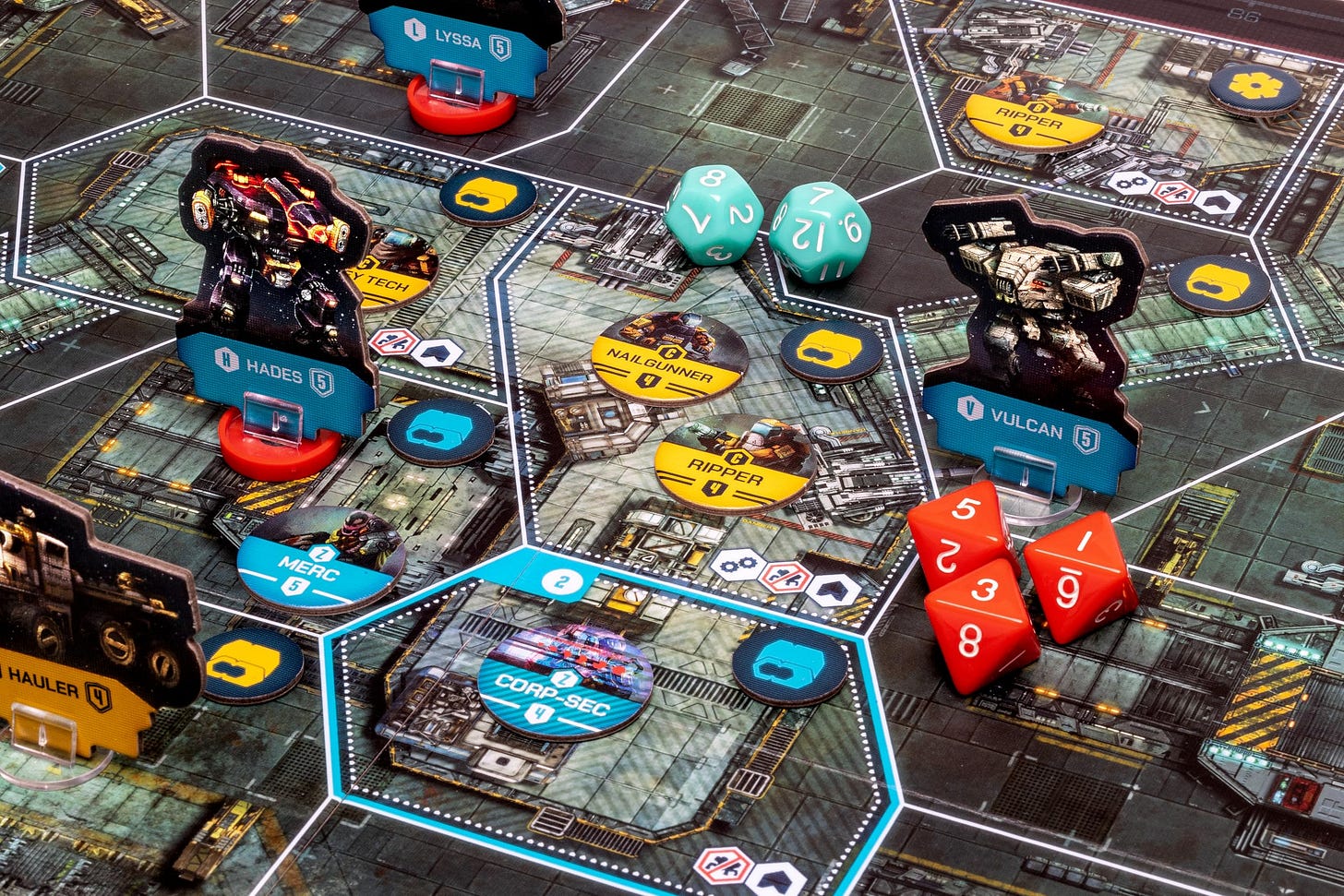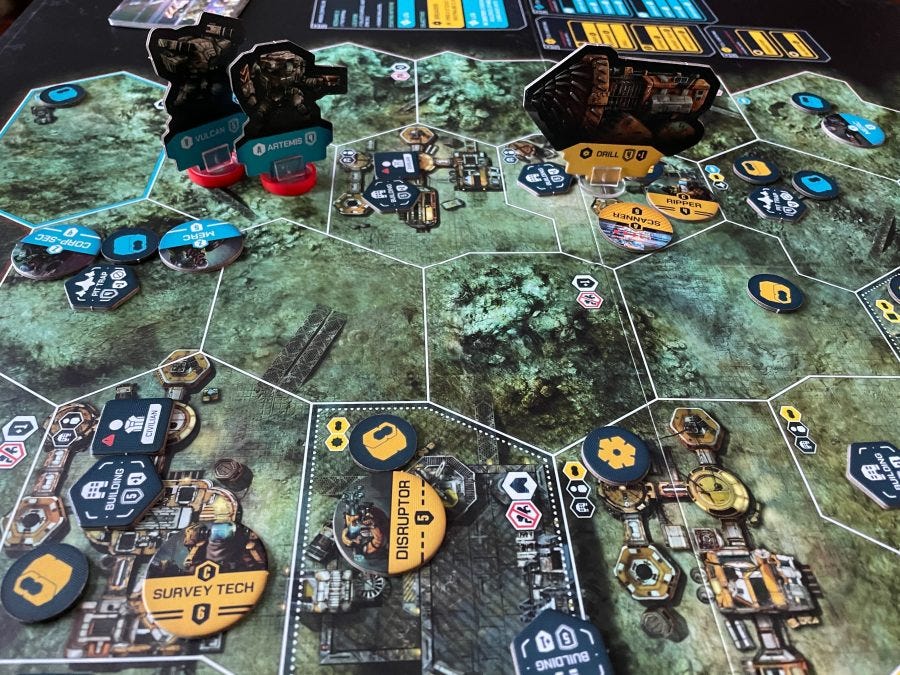The Undaunted series has been taking the board game world by storm for the past couple of years, with a rock-solid core system that mixes standard dudes-on-a-map wargaming with deckbuilding and a fun system for maintaining a short but exciting campaign across several modular maps. Where previous entries in the series have been pretty heavily focused in World War II — riflemen, tanks, and machine gunners, etc. — Callisto takes a new tack and shoots the series far into the future, with a couple of overhauls to the system to boot. How does this new take on a well-traveled system translate to the future?
The patented “Undaunted” system is, simply put, genius. Each scenario, you and your opponent will be given a small deck of cards representing your soldiers and some commands you can issue them. These soldiers (really, units of soldiers) are represented by tokens on a modular board constructed out of a few dozen square tiles as instructed by the scenario book. You’ll also be given a supply of cards you’ll have the opportunity to pull from throughout the game, should you so choose. Each round, you and your opponent will draw four cards and choose one secretly to use as your initiative for that round, which will then be discarded. Each card comes with a number, 1 through 9, which generally corresponds to how useful that card is to have in your hand. The highest number gets to go first (with whoever led the previous round breaking ties), which means if you want to get first dibs on the action, you’ll have to sacrifice one of the better cards in your hand.
On your turn, you’ll play the remaining three cards, each of which has a selection of actions you can take such as controlling a given location, moving, drawing extra cards, attacking an enemy, or bolstering your deck by taking cards from your supply. There’s a lot of subtle magic going on here. For starters, most units can’t move onto a space until it’s scouted, which means one of your surveying units will have to move there first. Upon doing so, you’ll scout the location, but you’ll also add useless “fog of war” (or “interference” in Callisto’s case) cards to your discard to gunk up your deck once you shuffle them in.
Additionally, bolstering from your supply isn’t always the right choice, depending on your situation. You could use it to pull duplicate cards for more chances to control units you’d like to use frequently, or you could pull new units to throw into the fray. You even have the option of returning cards back into your supply, because as any frequent player of deckbuilding games will know, often having a thin deck of high-value cards can be more effective than a huge collection. However, that’s not always the case, thanks to how attacking works.
Attacks in Undaunted games come in two flavors — normal, damage-dealing ones, and Suppress actions. Either way, the enemy’s defense value will come down to what’s listed on their token plus any bonuses from nearby friendly units, the space they’re on, and how far away from you they are. Callisto also adds elevation advantages, which add even more wrinkles to this. Once you’ve calculated the defense total, you just roll 1-4 dice (depending on what your card says) and if any of them meet or exceed the defense value, congratulations! You scored a hit. If you were performing an attack, you get to cause a “casualty,” forcing your opponent to remove a card matching that unit from their deck. If they don’t have one to remove, you’ve “neutralized” the unit entirely, making their life a lot more difficult. If it was a suppress action, you don’t get to cause a casualty, but their token gets flipped over and they’ll have to waste a card to get them back on their feet.
Thus, it’s very important how you choose to construct your deck. On the one hand, you can amass a huge number of troops by bolstering different types, but they’ll all be more vulnerable to neutralization because you won’t have many copies to spare. On the other hand, you could go all-in on one type of unit, guaranteeing their safety, but you’ll often have turns where you only get to do things with that unit if you don’t branch out.
Each scenario has a few different objective options, but usually you’ll need to control certain spaces. This becomes tricky once you realize that, usually, the units who can do this also move really slow and will need to be escorted by scouts before they can get to their objective. Finding clever ways to sneak your controlling units onto the spaces they need to be before your opponent is often key. After the dust has settled and a winner has been declared, you’ll usually be granted some kind of reward in the form of new cards or upgrades to your current ones to use in future scenarios, and then told what scenario to play next based on how the story is unfolding.
Callisto changes a few key things about this formula. First and foremost, there’s no longer any persistence between scenarios. You can play them in any order you like, and each time the starting setup will be exactly the same for both sides. There’s no upgrading or unlocking going on at all here, and it really doesn’t matter who wins or loses, either. You just pick one of the eight scenarios, and play it. The other major change is the removal of the modular map tiles in favor of four double-sided boards that come with everything pre-printed thereon. On the one hand this drastically reduces setup time and rules overhead — you only need to read what’s relevant to the symbols on this particular map — but it also reduces the number of scenarios you can feasibly cram into a reasonably-sized box and boosts the price somewhat substantially.
While I’m not necessarily a big fan of those changes, I love a lot of what Callisto adds. The story here is gritty and interesting, with shades of Alien in the lore and a visceral sci-fi conflict taking place. Because of the custom boards, the scenarios can get more interesting and detailed with their layouts and objectives, resulting in some really interesting missions where each side is pursuing totally different objectives while finding ways to thwart their opponent. The added elevation system is fantastic, too, adding d8s and d12s to the standard set of d10s to really make you consider where you attack from and incentivize better positioning.
The core gameplay loop remains delightful and satisfying, with an added sheen of coolness when you factor in the giant mechs, laser guns, and wacky objectives like freeing prisoners or tearing down buildings. Some scenarios even reminded me of Stationfall as I scrambled to reach the switch to open the doors while my scout bum-rushed the escape pods, dodging the flailing arms of my opponent’s massive mechs.
While I wouldn’t say Callisto is the best entry point for the Undaunted series, it serves as proof that this system has legs that can carry it beyond its typical, historically-anchored scope. The storytelling is creative, but comes at the cost of variety in some cases. In others, though, the variety is off the charts thanks to what can be done when you’re not limited to maps made of square tiles. Ultimately, Undaunted 2200: Callisto succeeds in ways its predecessors do, but also fails in a couple ways they don’t. Regardless, though, the Undaunted system is always a blast, and if sci-fi is your jam, you really won’t be disappointed by Callisto.







